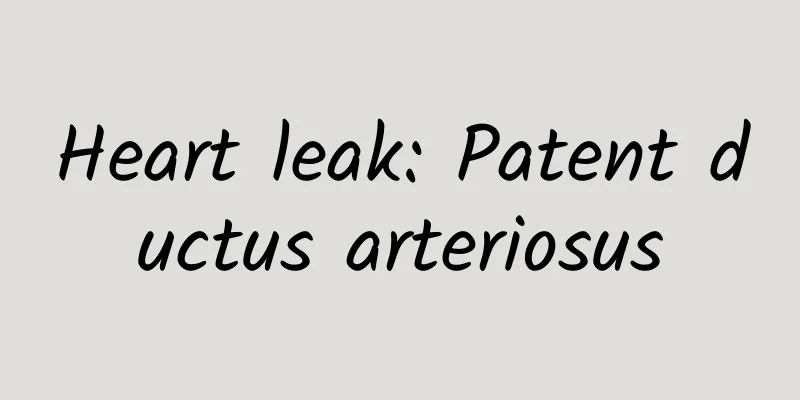Heart leak: Patent ductus arteriosus

|
Author: Zhang Xin, Chief Physician, Beijing Children's Hospital, Capital Medical University Reviewer: Wang Fangyun, Chief Physician, Beijing Children's Hospital, Capital Medical University In the wonderful journey of life, every detail is crucial, and patent ductus arteriosus, an "invisible passerby" in congenital heart disease, is one of them. It is like an unclosed door, making the originally orderly blood flow complicated and affecting the healthy growth of children. So, what is patent ductus arteriosus? Let us unveil its mystery together. 1. What is patent ductus arteriosus? In the journey of exploring the mysteries of the heart, patent ductus arteriosus is a chapter that cannot be ignored. To understand this concept, we first need to review the role of the ductus arteriosus in the fetal period. The ductus arteriosus is a special existence in the fetal blood circulation. It connects the pulmonary artery trunk and the aorta like a bridge, ensuring that the oxygen-rich pulmonary artery blood can smoothly enter the aorta and nourish the whole body of the fetus. However, with the birth of the newborn, the mission of this "bridge" has quietly changed. Shortly after birth, the ductus arteriosus will undergo functional closure, and gradually close in the following weeks, eventually becoming an arterial ligament, quietly guarding a corner of the heart. However, not all children's ductus arteriosus can complete this transformation smoothly. When this "bridge" fails to close as expected, it forms a patent ductus arteriosus. This is a congenital heart disease, and its occurrence is closely related to premature birth and genetic factors. Patent ductus arteriosus breaks the balance of blood flow inside the heart, causing part of the arterial blood to flow abnormally into the pulmonary circulation, thus causing a series of health problems. 2. What are the symptoms of patent ductus arteriosus? The clinical manifestations of patent ductus arteriosus vary from individual to individual, and its severity is closely related to the thickness of the ductus arteriosus. For premature infants, this disease may increase the burden on the lungs and increase the risk of pulmonary edema, pulmonary hemorrhage, and bronchopulmonary dysplasia. For full-term newborns and children, the symptoms are more complex and varied. A small patent ductus arteriosus may have no obvious symptoms and is only exposed during a physical examination due to a heart murmur or an incidental echocardiographic abnormality; a medium-sized patent ductus arteriosus may lead to left ventricular enlargement and dysfunction, and children often show exercise intolerance, restricted growth and development, and recurrent respiratory tract infections; a large patent ductus arteriosus may rapidly cause heart failure and respiratory dysfunction, seriously affecting the quality of life of children. Figure 1 Copyright image, no permission to reprint 3. What are the treatments for patent ductus arteriosus? In the face of the challenge of patent ductus arteriosus, the medical community has developed a variety of treatment methods. Premature babies can try drug treatment under the guidance and close monitoring of doctors in order to promote the natural closure of the ductus arteriosus. However, for full-term newborns and children, the effect of drug treatment is often limited. At this time, surgery or percutaneous minimally invasive closure surgery becomes a more appropriate choice. The specific method and timing of the operation need to be determined according to the specific situation of the child, including age, weight, thickness and shape of the ductus arteriosus and other factors. Cardiologists will tailor the most appropriate treatment plan for the child based on his or her condition and physical condition in order to achieve the best treatment effect. Figure 2 Copyright image, no permission to reprint In summary, as a congenital heart disease, the occurrence, development and treatment of patent ductus arteriosus are full of complexity and challenges. However, through scientific diagnosis and treatment methods, we can provide effective treatment and support for children with the disease to help them regain health and happiness. |
<<: World Allergy Day - Make allergic diseases no longer "difficult"
Recommend
How to treat back pain and excessive leucorrhea
When a woman's kidneys become deficient in ya...
Poor healing of uterine incision
We all know that cesarean section will leave scar...
Laser hair removal without knowing pregnancy
Important reminder: First of all, the pursuit of ...
Why can't we eat too much pork liver? The nutritional value of pork liver
Pork liver contains 18 times more iron than pork,...
What is the cause of right breast pain?
This kind of pain in the right breast may be caus...
What does raw milk mean? Is milk with only raw milk in the ingredient list good?
Raw cow's milk is rich in immunoglobulin, lac...
How to quickly replenish kidneys for women
Women generally have poorer physical fitness, so ...
What should I eat when I have my period?
Maybe every female friend of ours may have menstr...
Is ovarian chocolate cyst serious?
Uterine and ovarian chocolate cysts are more comm...
38 weeks pregnant, my stomach feels hard, tight and has a falling feeling
Pregnancy is a truly happy thing, and I believe m...
What causes itchy and peeling nipples?
Breasts are a symbol of female gender and play th...
What should you pay attention to during the pregnancy preparation stage?
The health and intelligence of the baby are close...
What medicine should I use for vaginal itching?
Itching in the vagina can make women feel very un...
What are the tips for buying integrated sinks? What materials are sinks made of?
Stainless steel sinks are the most widely used, a...









